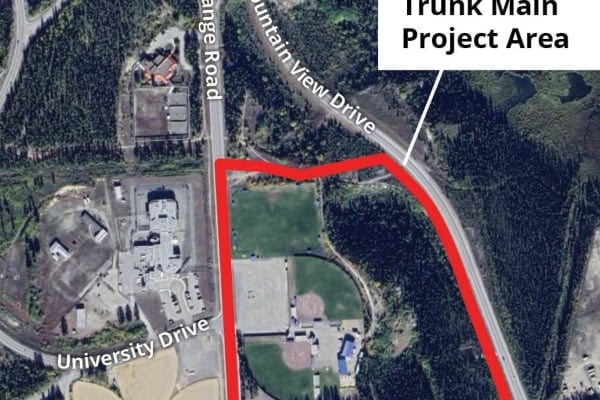-40 all month? Are you sure?
January 2018 was only a short time ago, but our memories are probably quite variable. Many of us will remember the brief warm spell when we had a high of +7ºC and above freezing temperatures for about 48 hours. Trails, roads and sidewalks were icy and treacherous for a couple of weeks. Most of us may have forgotten that we had a 20-centimetre snowfall in early January and two cold spells in the -30s.
In fact, January was only a bit warmer than the average of the last 30 years.
What is a normal January in Whitehorse? Based on statistics, a “normal” January has an average daily high of -14ºC and an average daily low of -22ºC, with at least one day above freezing and one day near or below -40. The average January has 24 centimetres of snow. But very few Januaries are average. And most of us remember the extremes, not the averages.
Analyzing 70 years of data, a typical January may be described as follows. Temperatures vary widely from -40ºC to +1ºC. January has one to three mild periods, with large variations in temperature, usually over a 48-hour period. January is a dry month with snowfall ranging from none to 40 centimetres.
We each tend to remember certain winters. Those of us born in the 1930s, may remember some extremely cold winters in the 1940’s. On January 31, 1947 a low of -52ºC was recorded. That translates to 62 below zero on the Fahrenheit scale, which explains why the old-timers talk about 60 below zero days.
Those who were born in the 1950s might remember the 1960s as being very cold, for a good reason. Two of the coldest winters in the last 70 years were 1966 and 1969. January 1966 had 12 days below -40ºC and on three of those days the temperature remained below -40ºC all day. That is why our 60-year-old friends keep talking about when winters were always cold.
The flip side of those cold memories are the warm winters that have been forgotten. There were several mild winters in the 1940s. January 1942 had an average high of -3ºC and an average low of -10ºC. The coldest day was -32ºC and the warmest was +5ºC. January 1961 was also mild, with the coldest day being -33ºC. Most Januaries in the 1960s were close to the long term averages. The lowest temperature in January 1985 was -20ºC.
The extremes of January may be best illustrated by the years 1981 and 1982. January 1981 was one of the mildest on record. There were 20 days that were 0ºC or warmer and the average low was -8ºC. There was a total of 43 centimeters of snow, but most of it melted. That was the year that Whitehorse had canoe races during Rendezvous and had to truck in snow for the first World Cup cross country ski race held in North America.
The following year, January 1982, was one of the coldest on record. The warmest day was -16ºC and the average high was -27ºC! There were 13 days below -40ºC and about 15 centimeters of snow. All those extremes only one year apart!
At least one conclusion can be made about January in Whitehorse. We have never had a January with -40ºC recorded every day.
The coldest and second coldest January in the last 70 years, 1969 and 1982/1966(tied) recorded minimum temperatures of -40ºC or colder on half of the days. In fact, our longest period of continuous -40ºC or colder is only seven days, and that was set in 1996. One of the warmest Januarys on record, other than 1981, was in 1942.
Another conclusion is that January, along with the rest of the Whitehorse winter months is more about wide fluctuations in temperature than it is about long cold periods.
Whitehorse is only about 150 kilometres from the Pacific Ocean with a wall of high mountains separating us from all that warm water. If the cold, dense Arctic air mass settles over the Yukon, the mountains hold it in place. But if the arctic air moves southward from Alaska over the Pacific, it pushes the warm Pacific air over top of the mountain barrier and into the Yukon.
The conversation isn’t complete without relating the data to climate change. In the last 35 years, January has definitely been warmer on average than the previous 35 years and more so in the last 10 years. The average daily high and low in Whitehorse for the last 10 years was -9ºC and -17ºC, compared to the averages of -14ºC and -23ºC for the period 1961 to 1990. To make conclusions about the whole winter, all of the months would have to be analyzed, because it is possible to have -40ºC on any given day, from November to March. An extremely cold November can be followed by a mild December and so on.
Even though the global climate is on a warming trend, it is difficult to make conclusions based on average and extreme weather from a single location. Climate trends are measured in one-degree increments, more or less, over a period of one or more years. Our local weather variations can be as much as 50 degrees in 48 hours.
Our weather memories are very individual and specific and we are prone to generalize to long periods, even a whole winter, based on very little data.
Even traditional knowledge has to be studied carefully, because we humans have very subjective opinions about last week’s weather, never mind last year or last century.
A note about this data
I arrived at the conclusions here by studying historical weather information provided by the Environment Canada website. Four temperatures were chosen for each January to represent the overall trends for the month.
In general, the two warmest and two coldest temperatures were selected and distributed over the four weeks and shown on the graph as x’s.
Data Based on Historical Weather information from 1949 to 2018 provided by Environment Canada.




